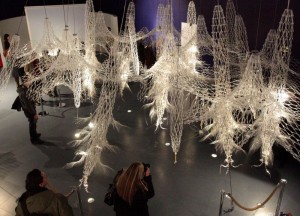Device Art
Ars Electronica Center
Level +1
Introduction
by Machiko Kusahara, Waseda University / Art-Sci Center, UCLA
Device Art is a new form of art. It bridges art, design, technology, science and entertainment by using both the latest and everyday technologies, and by introducing elements in Japanese traditional culture. Device Art visualizes and helps understanding what it means to live in a world full of new technology. It also pushes the border of art, as avant-garde movements such as Bauhaus did.
Appreciation of refined right materials and tools is a long tradition in Japan. As in tea ceremony, they mean more than something that temporary serve for certain purposes. In Device Art content is no longer separable from device. Artworks display the essence of technology through the use of new materials and devices, while they are often playful.
Appreciation of playfulness is deeply embedded in Japanese culture, often accompanied by mitate, a long and popular tradition of using metaphors, associations, and double meanings in a playful manner. It plays a magic to turn an ordinary or even trivial object into something extraordinary and unexpected, as in case of rocks and pebbles in Japanese gardens. Examples are seen in the exhibition. Mitate also allows an artist to set a serious theme behind a playful surface. Playfulness contributes in bringing art outside museums and galleries. Some of the works by these artists have been commercialized as gadgets. Art should be enjoyed in everyday life, according to Japanese tradition.
Fusion of art and technology is a strong trend in Japan. The exhibiting artists have led the movement since early 1990s. The Device Art project was launched in 2004 by a group of artists, engineers and researchers. The group is led by Hiroo Iwata with collaborators Hideyuki Ando, Masahiko Inami, Machiko Kusahara, Ryota Kuwakubo, Sachiko Kodama, Novmichi Tosa, Kazuhiko Hachiya, Taro Maeda, and Hiroaki Yano.
The project is funded by Core Research for Evolutional Science and Technology (CREST) of Japan Science and Technology Agency.



